This video is sponsored by Foreo.
Microcurrent devices are handheld electronic gadgets that have two metal spheres on them. There are lots of claims about how they tone and contour your face, so here’s the science behind microcurrent, how to use a microcurrent device and the results I’ve gotten after using the Foreo Bear on the right side of my face only for 3.5 weeks (this is probably the most asymmetric I’ve gotten for a review so far!).
The video is here on YouTube, scroll down for the written version.
What is microcurrent?
Microcurrent is basically a really weak flow of electricity, so weak that you generally won’t be able to feel it.
There are a few types of microcurrent devices. I’ve talked about iontophoresis devices before, where the current goes through your arm to push skincare ingredients into your skin. In those devices, there’s one electrode on your skin and one in your hand.
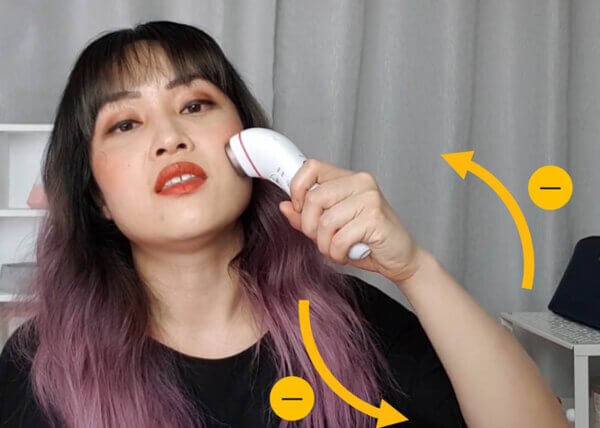
The more popular microcurrent devices I’m talking about in this post have both electrodes on your face, so the current only runs through a very short portion of your skin. These devices have currents in the 10 to 500 µA (microamp) range. For reference, 1 mA (milliamp) or 1000 µA is the detection threshold (the minimum you need to be able to feel it), while 10 mA or 10 000 µA will give you a painful electric shock.
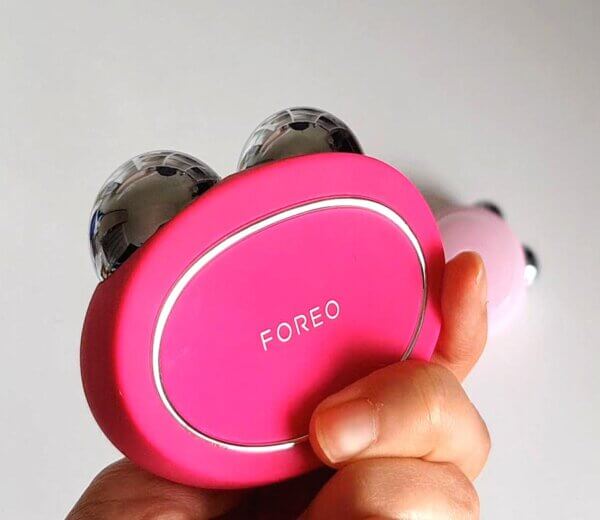
How does microcurrent work?
So how does microcurrent work? This is actually a pretty complicated question.
There are a lot of benefits that microcurrent devices claim to have. These are the most common ones:
- tightens and smooths skin
- tones, contours and lifts face
- more defined cheekbones and jawline
- boosts collagen and elastin
- reduces fine lines and wrinkles
- boosts circulation
- increases cellular activity
- decreases puffiness
The biggest problem is that there aren’t many direct studies on humans using microcurrent devices, so there isn’t much data to back up the claims, nor (more importantly, to me at least) to give us a better idea of how they actually work.
The direct studies aren’t very high quality:
- Self-administered microcurrent didn’t give much improvement in volunteers of unspecified age, as assessed by plastic surgeons
- Microcurrent improved wrinkles but the methodology is unclear
Let’s talk about the background behind what microcurrent could potentially do so we can understand what to realistically expect, and demystify some of the jargon behind these devices.
Electricity in your body
A lot of things in your body run on electricity, which is essentially a flow of charged particles. In a metal wire, there are lots of negatively charged electrons that can move along to create an electric current.
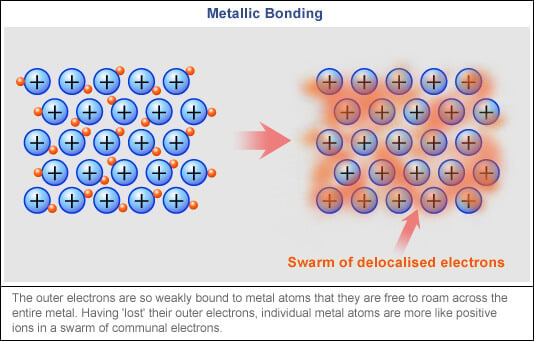
In your body there aren’t a lot of free electrons, but there are charged ions that can move. You might have heard of electrolytes in sports drinks, which are ions like sodium and potassium ions that your body uses for electricity.
Obviously since our bodies aren’t zapping around everywhere and interfering with our electronics, bioelectricity is at a pretty low level – in the microamp range, which is what’s in microcurrent devices.
Muscle size
The most obvious effect of microcurrent devices is increased muscle size. This is pretty much immediately visible, and if you keep on using the device, the effect lasts longer. That’s why it’s often said that microcurrent devices are like a workout for your face.
Your face muscles getting buff and swole explains a lot of the effects seen from microcurrent devices:
- As you age, your muscles start to shrink, which contributes to the saggy look, loss of plumpness and loose skin that we associate with older faces. With microcurrent, your muscles get bigger and so you end up with a younger look.
- The larger muscle also stretches out skin, which explains the tightened skin, and reduction in fine lines and wrinkles.
- Because the muscle is firmer and larger, it tones, contours and lifts your face, plus you get more defined cheekbones and jawline.
But why exactly does microcurrent make your muscles get bigger, and how long lasting should we expect this effect to be?
This is where it gets sort of murky, and the science gets a bit vague.
Strength training
One possible explanation is that the microcurrent is strength training your muscles, like you’re exercising them. Your body uses electricity for a lot of things, and the most obvious one is sending signals through your nerves. Electrical impulses from your nerves can make your muscles contract, which is how your body moves.
When you exercise a muscle you put it under strain, and this strain signals to the body (through a combination of tension, microscopic damage and metabolic stress) that it needs to produce more protein and muscle to deal with the extra work. But it takes about a week between exercise for your muscles to start actually growing, while the effect of microcurrent is pretty immediate.
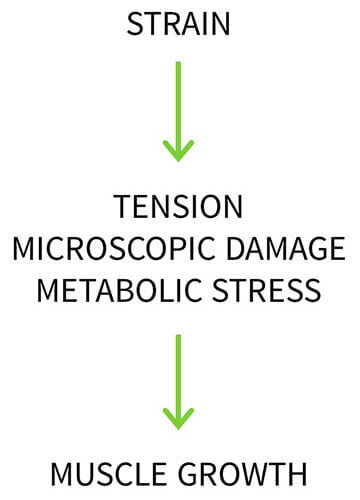
Again, we can look to strength training for an explanation (I learned a lot about bodybuilding while making this post). An immediate muscle size increase happens in strength training as well. It’s often called a “pump”, and this is when your muscles get temporarily super swole right after you work out. It happens when there’s accumulation of extra water and blood, and can also increase tension (again, signalling to the body that it needs to produce more muscle).
However, when it comes to muscle growth with electrical stimulation, it’s usually most effective when the muscle actually contracts properly. This is the basis of electrical muscle stimulation (EMS), those electric shock machines that you might’ve seen on some late-night infomercial. But with microcurrent, your muscle shouldn’t be visibly contracting. So it doesn’t seem like strength training would completely explain how microcurrent works.
ATP increase
The other common explanation for microcurrent’s effects is increasing ATP production. You might have heard that “the mitochondria is the powerhouse of the cell” – that’s because it produces ATP.
ATP or adenosine triphosphate is one of the main chemical sources of energy in your body. Mitochondria make ATP from nutrients that you get from food, and ATP is used to fuel lots of biological processes in your body, like protein production, moving ions around and muscle contractions.
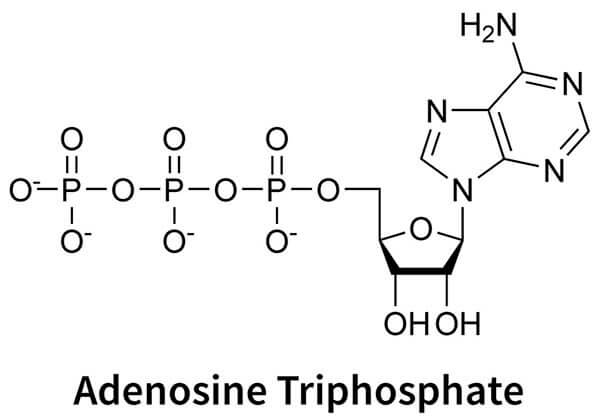
As you get older, your mitochondria tend to function less effectively, so you produce less ATP (although a lot of other things can affect this too, like using your muscles less). The production of ATP requires a flow of ions – an electric current – and that’s where microcurrent comes in.
It turns out that supplying a small current of 10-1000 µA for 2 hours to rat skin has been found to increase ATP production by up to 500%. This is the origin of the claim that microcurrent devices can recharge your cells, or provide cellular energy.
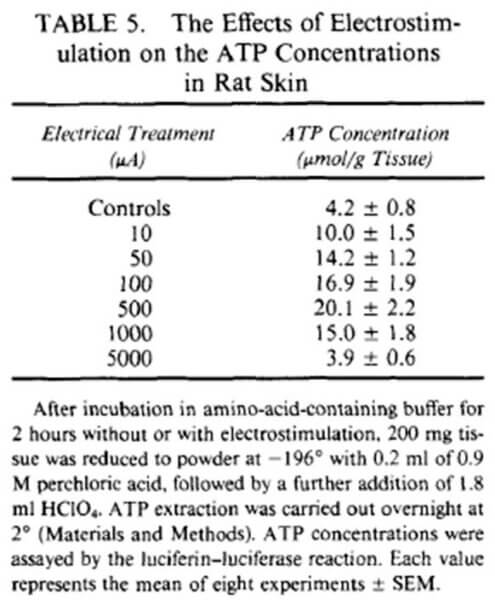
The production of proteins is affected as well. Electrical differences across membranes affects how amino acids (the building blocks of proteins) are moved around. In the same study, currents of 100-750 µA increased the transport of amino acids into cells. Both the ATP increase and amino acid transport effects can contribute to protein production and muscle growth.
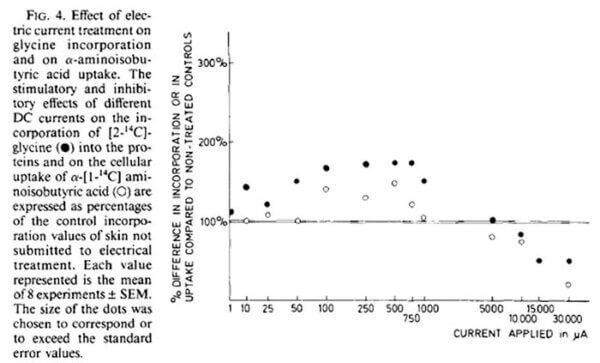
Interestingly, in this study, when 1000 µA or 1 mA (the smallest amount that you can feel) was used, there was actually decreased protein synthesis. So more isn’t actually better when it comes to electricity!
The flow of ions can also change how water moves around inside your muscle, which could explain the immediate plumping effect.
The problem is that there isn’t much evidence that what happens in in vitro rat skin studies also happens on your face, even though it’s quite plausible. There is some evidence from animal and human studies that microcurrents can increase muscle growth though. So it’s probably a combination of strength training and ATP production (and potentially some other things as well) that lead to these muscle increase benefits of microcurrent.
With the other claims, the fact that you’re massaging your face with these devices could explain boosted circulation and decreased puffiness.
For collagen and elastin increase, the idea is that since you have more ATP and ATP is used for everything, including collagen and elastin production, then having more of it around will lead to increases in collagen and elastin. This would make sense if it’s lack of ATP that’s limiting collagen and elastin production.
There’s a study by a Dr Emil Chi in 2003 that a lot of microcurrent sites talk about: skin tissue treated with microcurrent had a 45% increase in collagen and 10% increase in elastin. But you can’t actually seem to find this study anywhere, so I’m not sure it actually exists. There are some studies where microcurrent did increase collagen production (e.g. 90 hours of microcurrent increased collagen in rat heart samples in this study). Obviously there’s a really big difference between that situation and your face, so it’s certainly plausible but not exactly convincing.
Is microcurrent worth it?
So is microcurrent worth it?
All in all, microcurrent has a really dramatic immediate effect, and potentially some longer-term anti-aging benefits as well. But those longer-term effects aren’t really well tested, so there’s no guarantee that they’ll actually happen. But I think there are still some really big things going for microcurrent.
The biggest advantage is that it targets muscles, which are incredibly difficult to reach with skin care products. Normally, you’d need to change these with botox, fillers and surgery – so that’s the comparison we should be making with a microcurrent device, rather than skincare. Compared to botox, fillers and surgery, microcurrent isn’t actually that expensive, and there’s only a small time investment and minimal side effects.
At the very least, there’s a short-term lifted appearance after only 2 or 3 minutes, and it lasts for a decent amount of time (half a day to a few days). That’s enough to make a difference to your appearance that would be really hard to achieve otherwise – compared to applying makeup daily, the time investment isn’t significant.
The potential long-term effects would be a great bonus, but even if you only believe in the immediate effects it can be worth it, especially if your face is starting to droop (and of course, if you’ll actually end up using the device and not have it sitting in a drawer).
One really good thing about microcurrent is that you can quickly gauge the sorts of effects you’ll eventually get after your first use, and decide whether or not you like them. Unlike a lot of skincare products, you don’t have to wait for weeks or months to see if the investment is actually worth it.
Microcurrent vs face exercises
One other popular non-invasive to enlarge face muscles is facial yoga, or facial exercises. I think microcurrent has a few advantages over them.
First it’s less time consuming – you’re only meant to use microcurrent devices for less than 5 minutes a day, while facial exercises are meant to be done for about 30 minutes.
There’s also the fact that you often can’t purposely exercise the muscles that you want to exercise. We tend to get trained into unconscious patterns of what muscles we like to use, and it’s really hard to untrain that – if you’ve ever been to a physiotherapist, you know that a lot of it is desperately trying to clench muscles that you’ve just found out you haven’t been clenching correctly your whole life. If you do the facial exercises correctly you should be targeting the right muscles, and not overexercising the ones that are already really swole, but with microcurrent it’s a lot easier just to shove the device on the correct muscle.
Facial exercises also make you contort your face a lot, and unfortunately, repetitive facial movements is how wrinkles are etched into skin. That’s why a lot of wrinkles are called expression lines – crow’s feet and marionette lines from smiling, smokers’ lines from pursing lips. It’s like how wrinkles form on a leather wallet in the places that get bent the most. Facial exercises could potentially be deepening your wrinkles while it’s plumping up your face, but with microcurrent your face doesn’t actually move.
The downside with microcurrent is that you actually have to go and buy a device, and it’s a bit harder to use it while you’re driving or waiting in a line.
At-home microcurrent devices
There are quite a few at-home microcurrent devices on the market. Obviously they’re a bit weaker than the in-clinic versions, so it’s recommended that you use these close to every day.
Both the Foreo Bear and Bear Mini are pretty small and portable. The Bear is a bit larger and designed for all over face treatment, while the Bear Mini is smaller and meant for more targeted treatment, like around your lips. Both have hemispherical electrodes and a silicone body, so you can actually wash these with soap and water.
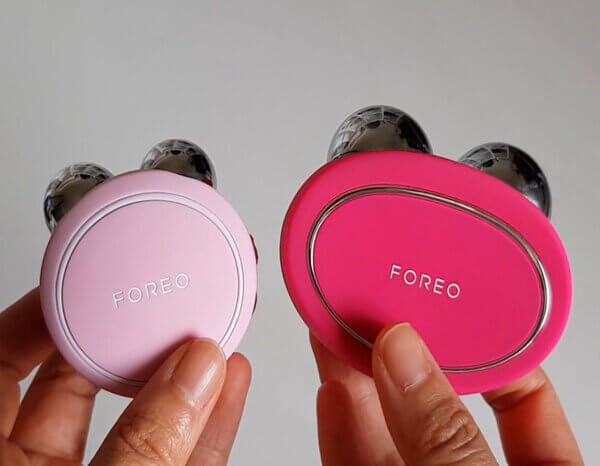
As well as microcurrent, both of these have Foreo’s T-sonic pulsations which were featured in Foreo’s earlier devices, the Luna and the UFO. These are meant to massage your face and help your products absorb better.
You can adjust the intensity of the microcurrent (the Bear has five levels, the Bear Mini has three), and the T-sonic pulsations can be turned on and off. The Bear has the anti-shock system, a special safety feature scans your skin resistance 100 times per second, and adjusts the current to suit it in 0.002 seconds. This guarantees a shock-free treatment, which is good if you’re a bit scared of microcurrent devices (it doesn’t make it any less powerful though – the Bear is actually more powerful than a lot of other devices, operating with 50 pulses per second).
My microcurrent results
I’d been using the Bear on just the right side of my face every night for the last 3 weeks before making this video, and was relieved to finally be able to even up my face!
To me the results are pretty dramatic, but it’s a bit subtle on video. I can feel the asymmetry quite strongly when I smile – it feels a lot tighter on my right side, like I’ve exercised and my muscles have gotten toned, and they feel a lot more firmer and more in control.
When I poke my cheeks, the right side also feels a bit firmer, and if I tilt my head forwards the nasolabial fold is also a bit less deep on the right side.
In the video I use the Bear on my left side, which hasn’t had a microcurrent treatment for a few months. The process is:
Start with a clean dry face. This is so the current isn’t interrupted when it flows through the device and through the skin. When it’s flowing correctly, you shouldn’t be able to feel much on your face, aside from perhaps feeling a little bit firmer.
Apply a thick layer of conductive gel. Electricity likes to take the path of least resistance, through the more watery areas of your face like the deeper skin tissues and the muscle. But the dead skin on the surface of your face is quite dry, so it needs to be wetted with a gel. Most microcurrent brands have their own gel (Foreo has Serum Serum Serum, a really nice hyaluronic acid serum), but you can also use aloe vera gel or ultrasound gel.
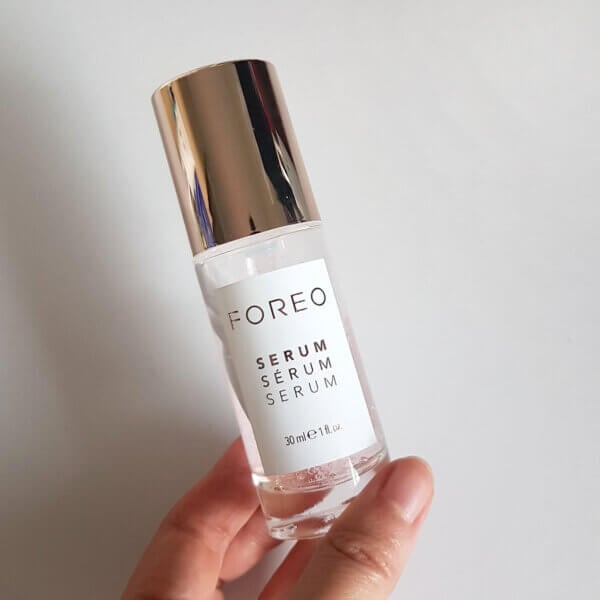
The problem I’ve found with every gel I’ve tried is that the gel starts drying out and not conducting properly if you just apply it all over at the start – when it doesn’t conduct properly, you can start getting this little prickly feeling. I find it easiest to apply the gel to each area right before treating it, and then move on to the next spot.
(The prickly feeling isn’t really painful, but it’s a bit uncomfortable, like being snapped with a tiny tiny rubber band. It tends to happen when you don’t have enough gel or if you’re moving over a hair or pimple that’s interfering with how well that electrode makes contact with your skin).
Use with or without the Foreo App. You need to download the Foreo app to activate the devices the first time you use them, then you can either follow the routine in the app or adjust it yourself with the button or through the app. At the moment there’s only one routine in the app but there are more coming.
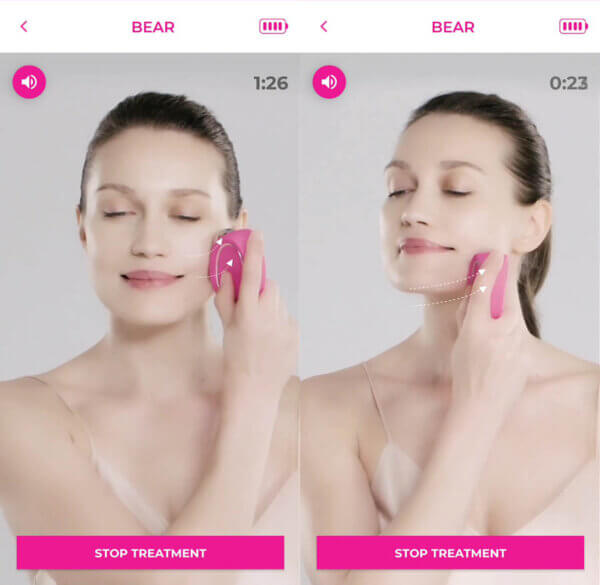
I’d recommend using the routine in the app the first couple of times (the Bear and Bear Mini intensities will adjust for you automatically), but it’s pretty easy to use with just the button. It’s a long press to turn on or off, a short press to cycle through the intensities (shown with lights), and a quick double press to turn the T-sonic pulsations on and off.
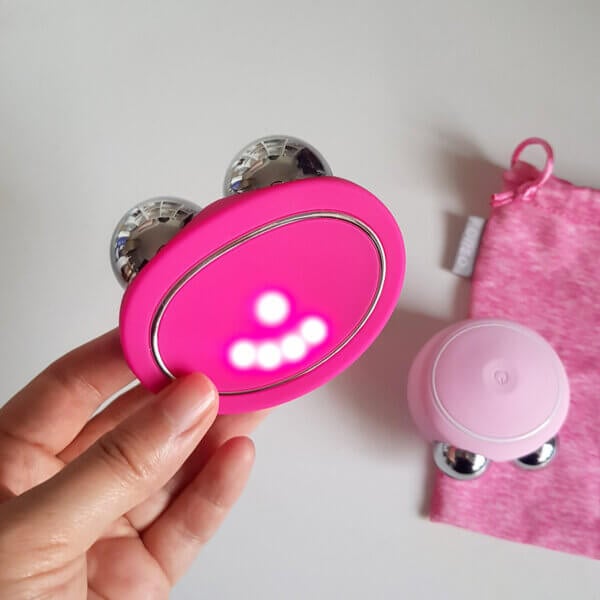
After selecting the intensity, you simply glide the spheres upwards on your face with minimal pressure, avoiding the eye area and the middle of your neck. When both the spheres are touching your face, the light in the middle switches off so you can see that it’s working properly. I usually watch another video on YouTube while I do it, and keep an eye on the timestamp to keep track of time. The device turns off automatically after 3 minutes.
One thing I really appreciate about these Foreo devices is that you don’t have to recharge them a lot – I’ve been using the Bear on a single charge for the whole 3.5 weeks (and counting!). You can use them for 90 uses per charge, and charging takes 90 minutes through a simple USB cable, with no bulky cradle.
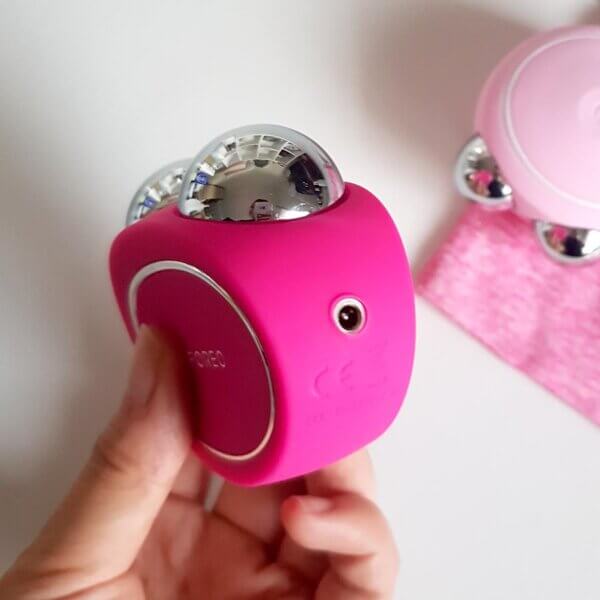
Here are the results before and after evening out my face. It turns out it’s stupidly hard to smile the exact same amount at the exact same angle for comparison, and the results definitely could’ve been more dramatic (I only did 3 minutes on a lower setting), but there are some visible differences (they’re a bit more obvious in the video, I think). I could feel the muscles activating a more than before.
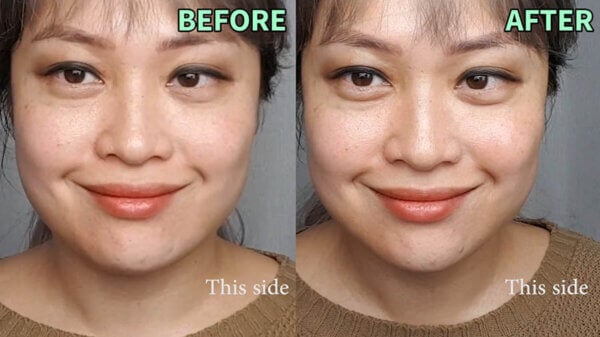
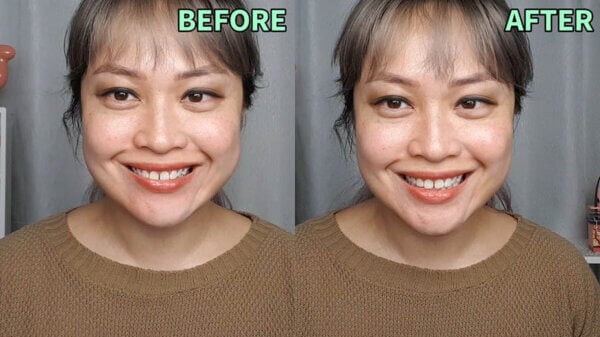
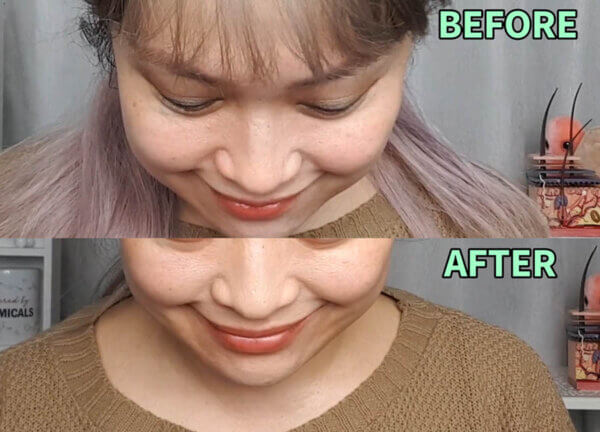

The cheek is a bit more defined, and the jawline is sharper and more symmetrical. It’s a bit hard to tell, but I was having trouble smiling evenly at the start of the video, because the two sides felt so different. After doing my left side as well, it felt a lot more natural.
I don’t think my mouth is really symmetrical at the best of times, but comparing me talking before and after, it’s evened out a lot. Now I’m feeling really awkward about walking around for weeks super lopsided, instead of regular lopsided!
Have you tried microcurrent? Share your tips for getting the best results out of your microcurrent device!
References
Cheng N, Van Hoof H, Bockx E, et al., The effects of electric currents on ATP generation, protein synthesis, and membrane transport of rat skin (open access), Clin Orthop Relat Res 1982, 171, 264-272.
Lee S, Most SP. A prospective examination of the efficacy of 2 noninvasive devices for treatment of the aging face, Arch Facial Plast Surg 2006, 8, 66-68. DOI: 10.1001/archfaci.8.1.66
Schoenfeld BJ, The mechanisms of muscle hypertrophy and their application to resistance training (open access), J Strength Cond Res 2010, 24, 2857-2872. DOI: 10.1519/JSC.0b013e3181e840f3
Kemmler W, Weissenfels A, Willert S, et al., Efficacy and safety of low frequency whole-body electromyostimulation (WB-EMS) to improve health-related outcomes in non-athletic adults: a systematic review (open access), Front Physiol 2018, 9, 573. DOI: 10.3389/fphys.2018.00573
Kwon DR, Kim J, Kim Y, et al., Short-term microcurrent electrical neuromuscular stimulation to improve muscle function in the elderly: A randomized, double-blinded, sham-controlled clinical trial (open access), Medicine (Baltimore) 2017, 96, e7407. DOI: 10.1097/MD.0000000000007407
Fujiya H, Ogura Y, Ohno Y, et al., Microcurrent electrical neuromuscular stimulation facilitates regeneration of injured skeletal muscle in mice (open access), J Sports Sci Med 2015, 14, 297-303.
Ohno Y, Fujiya H, Goto A, et al., Microcurrent electrical nerve stimulation facilitates regrowth of mouse soleus muscle (open access), Int J Med Sci 2013, 10, 1286-1294. DOI: 10.7150/ijms.5985
Macfelda K, Kapeller B, Holly A, et al., Bioelectrical signals improve cardiac function and modify gene expression of extracellular matrix components (open access), ESC Heart Fail 2017, 4, 291-300. DOI: 10.1002/ehf2.12169
Gonzales S, Wang C, Levene H, Cheung HS, Huang CC, ATP promotes extracellular matrix biosynthesis of intervertebral disc cells (open access), Cell Tissue Res 2015, 359, 635-642. DOI: 10.1007/s00441-014-2042-2
Sreedhar A, Aguilera-Aguirre L, Singh KK, Mitochondria in skin health, aging, and disease (open access), Cell Death Dis 2020, 11, 444. DOI: 10.1038/s41419-020-2649-z
Lee S, Most SP, A prospective examination of the efficacy of 2 noninvasive devices for treatment of the aging face, Arch Facial Plast Surg 2006, 8, 66-68. DOI: 10.1001/archfaci.8.1.66
Saniee F, Shirazi HRG et al., Consider of micro-current’s effect to variation of facial wrinkle trend, randomized clinical trial study, Life Science Journal 2012, 9, 1184.
The video is sponsored by Foreo; however, the content is all based on my independent research and my honest experience. For more information, see Disclosure Policy.







I keep a spray bottle of water handy and just spray when it feels like the gel is getting dry. Do you think that’s ok?
I do that with a thermal water! I’ve found that it does make the gel runnier though, and when it goes thin like that I tend to feel the current more.
is the current on the little bear as strong as the bear? i’d like to use it around my lips…or can I also use the big bear around my lips? thank you for this informative piece!
Great read, thank you! Do you not find it interesting that FOREO don’t disclose how many micro amps their devices are? Other products on the market are very forthcoming with this information
The problem is that the Anti-Shock system varies the current based on skin resistance, so stating the current would be misleading – the maximum current that the Bear puts out is comparable to/slightly higher than Nuface’s.
I’ve had the Bear since January, when I picked it up on a trip to Singapore. There was so little info on it at that time, so I had to experiment a lot. Eventually, I settled into a tag-team routine with my Foreo UFO. I love my UFO, but I don’t use the Foreo masks. Instead, I split a cotton pad in half, dampen it with some mineral water that has a few drops of glycerin in it, and then put my own moistures/serums (oil free) on it. When I’m done with the UFO, I remove the cotton pad and spray it with a little more water. Then I just wipe down one section of my face at a time as I use the Bear, sort of like using a toner. I’ve found this works quite well and I don’t have to change the skin care products I’m using.
I am using the NuFace, but struggle to do it often enough to really be able to judge the results.
I’ve been thinking of buying The Bear and really appreciate your review. I was wondering if something like Cosrx Snail Mucin would be effective as the gel.
Is this tech different to the Cleo Q system? ‘Via strategically positioned electrode pads, Cleo Q transmits a unique series of intermittent pulses that replicate the rapid nerve signals inherent in youth to revive and retrain your deep muscles layers.. multi-sequence pocket release pulse transmission reaches more of your facial muscles than any other non invasive face lift treatment. It works 95% of your deep muscle, so it makes sense that it is the most successful at bringing lasting results!’ https://www.club-cleo.com/cleo-q-face-body-toner/#:~:text=How%20does%20Cleo%20Q%20work,retrain%20your%20deep%20muscles%20layers.
*I used the Cleo II, then Q, religiously for years; wasn’t sure if it worked but carried on just in case it did-! Then kids/less time & I stopped using it 10yrs ago- My face has of course naturally aged / sagged since & I’m wondering if the old gadget will help or will I be wasting time.
I have a problem getting it to work without using the app, can you tell me what I might be doing wrong? Sometimes I even get a couple swipes and then it stops. Thanks so much.
I find the bear to be very finnicky as to what gel you use (and how much). It seems to prefer lighter/more fluid gels than anything too thick/viscous. For example, it frequently stops working when I use the standard Nuface gel or aloe vera gel. By which I mean the middle light will not go out when in contact with the skin. If the middle light does not go out, then it is not conducting (and therefore will have no effect). It’s worth pointing that out, because the T-Sonic vibrations can still work in app mode even when the microcurrent isn’t conducting, which can lead you to think it is working when it isn’t. If using with the app, the T-Sonic pulsations are on constantly, even when the bear is not in contact with your face or if it is not conducting. However, if used manually without the app, the T-sonic pulsations only work when the microcurrent is actually conducting (when that middle light has gone out). I’ve had so many problems with mine stopping during use, that I switched to sheet masks instead of gels, which work perfectly (Klairs rich moist sensitive masks or Benton Aloe vera mask works well and suits my sensitive dehydrated skin). I alsways wash and dry the bear after use, but even though it starts off clean, when using with the gels, if the bear gets too gunky (which can happen after a few swipes) it will stop working. It can sometimes help to thoroughly wash off any residue, dry it and start again. If you have applied too much gel to your face, or applied it on damp skin, that can also prevent the bear from working. Sometimes waiting for it to absorb/dry a bit can help, or washing it off and starting again. However, sometimes that doesn’t help either. The sheet masks have never failed me and give a stress-free experience compared with all the difficulties with gels (perhaps foreo serum works, but it contains inflammatory ingredients and is super expensive). The masks are expensive though, so I use each mask twice (two consecutive days). Hope that helps. It was driving me mad and I couldn’t find any answers anywhere – including from Foreo! 🙂
I got the bear a few weeks ago. I used it everyday for 2 weeks but I have realized that for me I get sensitive and I need to skip a few days as I started to feel a tingly sensation. I use aloe gel and cosrx snail mucin.
I’m enjoying the results.
Is there any evidence to suggest that home microcurrent devices could cause facial fat loss? I find my face looks a lot slimmer, smaller and flatter from using the Bear. Is this just toning of muscle and lymphatic drainage/”detoxification” of fat cells? Or can microcurrent cause apoptosis like with radiofrequency and laser devices (that causes fat cells to break down)? I’m desperate for an answer and can’t find one anywhere. Foreo and Nuface ignore all inquiries of this nature, which is worrying. Thank you.
Yikes, I would stop using it. I had that happen to my face with Light Stim for Wrinkles. I’m still devastated, and looking to do a fat transfer on my face. Also, company would not reply to my queries. I’ve heard about Foreo and was trying to find out if it heats the fat layer, which could potentially cause fat loss in my opinion. Most Light Stim users seem happy with results but there were other users who had similar problems to myself. My advice would be definitely to stop till you thoroughly research. It would be great if Micelle could weigh in on this topic. Good luck!
I just wanted to ask why I can feel a deep prickly feeling only around my forehead. It also feels like my skin is heating up. There was plenty of gel, the area wasn’t dry. Everywhere else on my face, cheeks and neck are fine. It was just my forehead. I’ve only used it twice but both times I had the same issue.
Thanks!
Hi Linda,
I just used my bear mini for the first time today and I feel the exact same thing, along with an electric tingling sensation all down my scalp when I approach the top of my forehead! Did you manage to resolve this or figure out why it happens?
To Linda and Em. Not sure if you guys have found an answer to your questions, but just in case you haven’t, the tingling sensation near your scalp, is merely the fact you don’t have fat on your forehead.
It’s nothing to be concerned over.
You can also experience the stinging sensation when you’ve put the device on too high a level, and there isn’t enough gel.